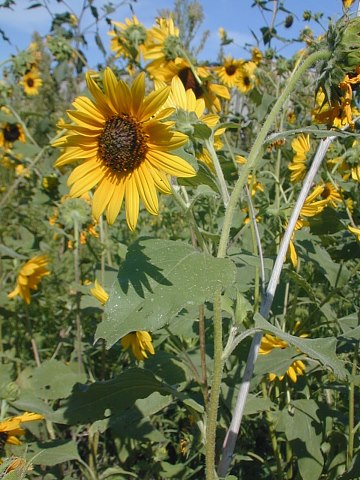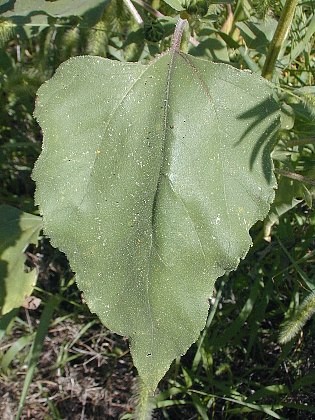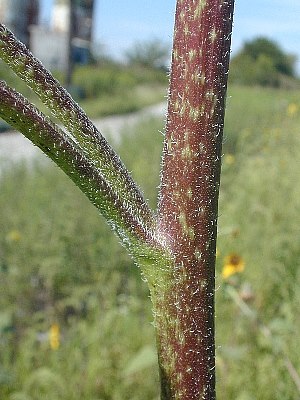Description: This is an annual wildflower with a large and stout central stem about 3-9' tall, although occasionally smaller. Toward the apex of the plant, there may be a few side stems, but it is tall and columnar overall. The central stem is light green to reddish green, terete, and covered with stiff spreading hairs. The large alternate leaves are up to 8" long and 6" across – they have a tendency to droop downward from the long petioles. They are cordate, ovate-cordate, or ovate with fine dentate margins, although some of the small upper leaves may have smooth margins and a lanceolate shape. The upper surface of the leaves is dull green and covered with short stiff hairs, providing it with a sandpapery feel. The petioles are light green to reddish green, and covered with short stiff hairs; the upper surface of each petiole is channeled.

The
daisy-like flowerheads consist of numerous central disk florets (each
about 1/8" across) that are yellow to brown; they are surrounded by
approximately 20-40 ray florets. The petal-like extensions of the ray
flowers are yellow. Each flowerhead is about 3-5" across. At the bottom
of each flowerhead, there are large overlapping bracts in 2-3 series.
These floral bracts are dull green, stiffly hairy, and ovate in shape,
tapering abruptly to form long narrow tips. An average plant will bear
from 1-12 of these flowerheads, and bloom from mid- to late summer for
about 1½ months. There is not much of a fragrance, although the florets
have a musty smell that is peculiar to sunflowers. During the fall, the
disk florets are replaced by large seeds that are ovoid and somewhat
flattened in shapee; they are dispersed by gravity when the tall plants
topple over during the winter. Like many other species in its genus,
the Annual Sunflower exudes chemicals that kills off other kinds of
vegetation. Thus, it has a tendency to form colonies that exclude other
plants, particularly in disturbed areas.

Cultivation:
The preference is full sun, moist to slightly dry conditions, and a
fertile loamy soil. However, this wildflower often thrives in soil with
a high clay or gravel content. There is a natural tendency for the
lower leaves to shrivel and drop whenever there are extended spells of
hot dry weather. Powdery mildew sometimes attacks the leaves during the
fall, but this is usually after the plant has finished blooming and is
forming seeds. It is easy to start new plants from seeds.
Range & Habitat:
The native Annual Sunflower occurs throughout Illinois; it is
especially
common in the central and northern areas of the state (see Distribution
Map). Habitats include disturbed areas of mesic to dry
prairies, meadows in wooded areas, cultivated and abandoned fields,
pastures, areas along railroads and roads, and urban waste areas.
Annual Sunflower may occur sporadically as individual plants, or in
small to large colonies that persist year after year. This rather weedy
wildflower can be controlled by summer wildfires or periodic mowing.
Faunal Associations:
Long-tongued bees are the most important pollinators of the flowers,
including the honeybee, bumblebees, digger bees (Melissodes
spp.), and leaf-cutting bees (Megachile spp.).
Short-tongued bees that are important visitors of the flowers include
Halictid bees, alkali bees, and some Andrenid bees. Some bees are
specialist pollinators (oligoleges) of sunflowers; the oligolectic bees
Andrena accepta, Andrena helianthi,
Dufourea marginatus, Melissodes agilis,
and Pseudopanurgus rugosus have been observed to
visit the flowers of Annual Sunflower. Visitors of lesser importance
include bee flies, butterflies, skippers, and the Goldenrod Soldier
Beetle (Chauliognathus pennsylvanicus). These
insects are searching for nectar and pollen. In addition to these
floral visitors, many insects feed on the leaves and other parts of Annual Sunflower and other sunflowers (see Insect Table).
Prominent among them are leaf beetles, various weevils, larvae of
leaf-miner flies, larvae of gall flies, larvae of Tephritid fruit
flies, aphids, treehoppers, grasshoppers, larvae of many moths, and
larvae of such butterflies as the Gorgone Checkerspot (Chlosyne gorgone), Silvery Checkerspot (Chlosyne nycteis), and Painted Lady (Vanessa cardui). Because the seeds
are abundant, large-sized, and nutritious, they are an attractive food
source to many vertebrate animals, including upland gamebirds,
songbirds, ground squirrels, tree squirrels, and mice. To some extent,
the seeds are distributed by these animals to new locations. Mammalian
herbivores, such as rabbits, ground hogs, and deer, often consume the
foliage, particularly from young plants. When this sunflower grows near
sources of water, muskrats and beavers sometimes eat its stems and
other parts; beavers also use the stems in the construction of their
lodges and dams.

Photographic
Location:
The above photographs were taken along a railroad near Champaign,
Illinois.
Comments:
The Annual Sunflower is thought to be adventive from western United
States. However, it was cultivated as a source of food by native
Americans, and was likely introduced to Illinois by them prior to
European settlement. The cultivated sunflower of modern agriculture is
a self-pollinating hybrid of this plant and another annual sunflower
that occurs in the Great Plains. Because of its large heart-shaped
leaves, it is easy to distinguish the Annual Sunflower from other Helianthus
spp. (Sunflowers) that occur in the Midwest.